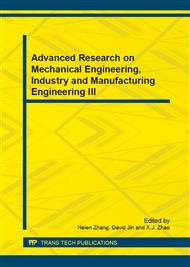p.543
p.547
p.553
p.557
p.561
p.566
p.572
p.576
p.581
Optimization Design Method for Body Frame of Vehicular Glass Edge Grinding Machine Based on Goal-Driven Optimization
Abstract:
In the application of the Vehicular Glass Grinding Edge Machine (VGGEM), in order to enhance the body frame rigidity, it is necessary to reduce the maximum body frame deformation by optimizing the body frame cantilever beam cross-sectional size. Considering to this point, a CAD model of the VGGEM is built by using Pro/E, then, further be divided into a simplified grid model by using ANSYS WorkBench. Based on goal-driven optimization method, the grinding wheel load is worked out by using the maximum body frame deformation, and the optimum body frame cantilever beam cross-sectional size is figured out by using the stress distribution of the grinding wheel and the maximum deformation constraints. After the performance analysis of the optimized designed body frame of VGGEM, its rigidity and strength are proved.
Info:
Periodical:
Pages:
561-565
Citation:
Online since:
August 2013
Authors:
Price:
Сopyright:
© 2013 Trans Tech Publications Ltd. All Rights Reserved
Share:
Citation:


